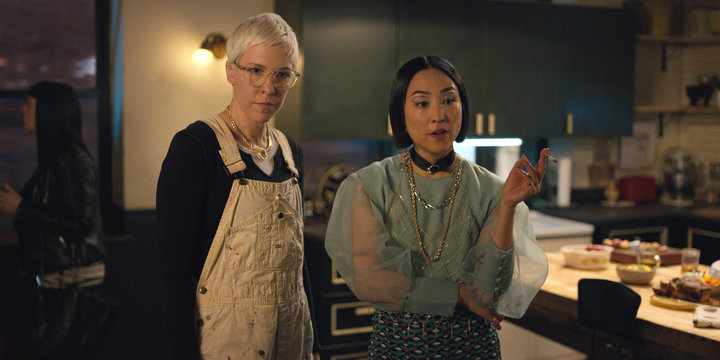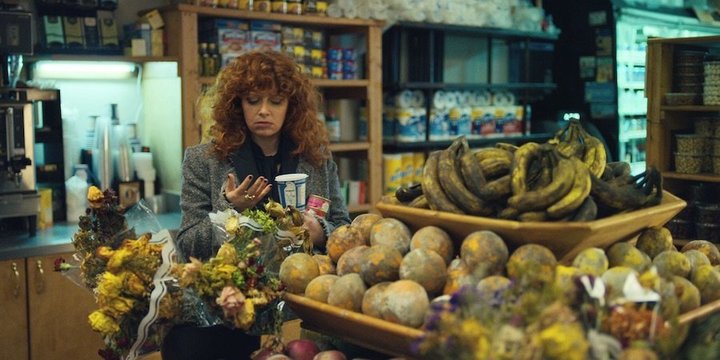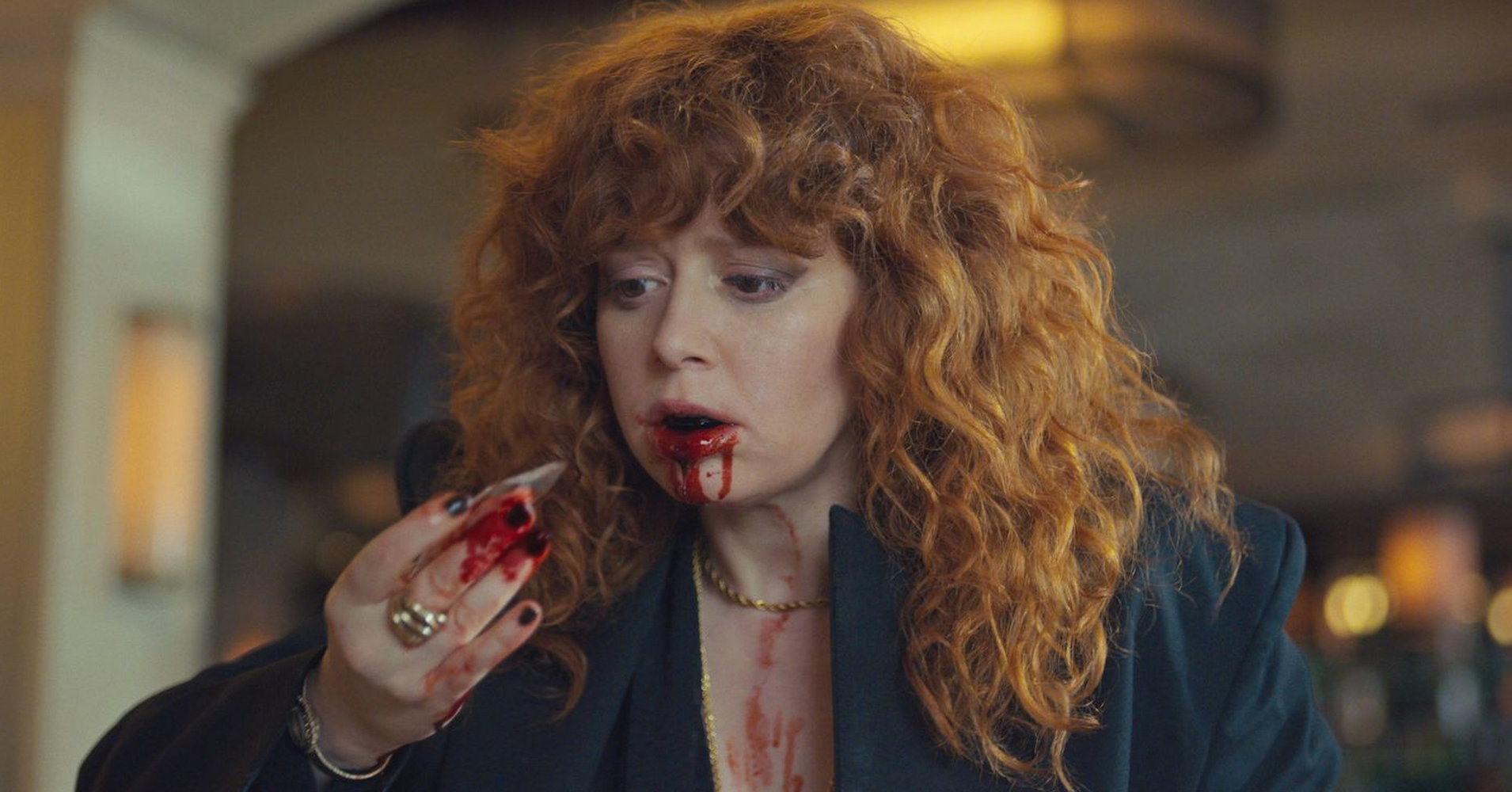[ad_1]
Nadia Vulvokov is gazing at her reflection in the bathroom mirror. It’s her 36th birthday party, and the celebration is bittersweet, in part because her mother never made it to that age. Unfortunately for Nadia, she hardly gets to experience it either. Later that night while roaming the streets for her cat Oatmeal, she’s hit by a car and dies.
Nadia Vulvokov is gazing at her reflection in the bathroom mirror. She’s back at her 36th birthday and feeling very WTF, having just died and come back to life and all. Her efforts to unravel what exactly is going on are thwarted, however, when she falls into the East River and drowns.
Nadia Vulvokov is ― you get the picture. This is “Russian Doll,” the new, mind-bending Netflix series from Natasha Lyonne, Amy Poehler and Leslye Headland. We follow Nadia (Lyonne) on her quest to escape her pesky loop of death, the situation growing weirder and more dire by the reboot.
Should you watch “Russian Doll”? Let’s just answer that right now: Yes, you should watch it. Go watch it right now. What makes the show so compelling? HuffPost writers Claire Fallon and Priscilla Frank, fans of the uncanny and the comedic alike, sat down after their “Russian Doll” binges to unpack this matryoshka-like treasure.

Claire: Despite all the comparisons “Russian Doll” inevitably evokes, I have to say it’s like nothing I’ve ever seen before. The title suggested a Cold War-era spy thriller starring Natalie Portman; the premise is reminiscent of “Groundhog Day,” “Happy Deathday” or, unfortunately, the Netflix rom-com “When We First Met.” Instead, it was a mesmerizingly original dramedy with a digital steampunk flavor and a warm heart. I’m still processing it!
Priscilla, I must note that you have curls just as luscious and buoyant as Natasha Lyonne’s character Nadia Vulvokov ― but did your affinity for the show go any deeper than hair-level?
Priscilla: Wow, thank you so much. This chat is off to a great start. Yes, I loved the show. As someone who has trouble making tangible changes in her life and loathes birthdays, I found it pretty easy to identify with Nadia even without the experience of being trapped in an existential death loop. I mean, who among us hasn’t stared desolately into the mirror at their birthday party like, oy, this again. Another year, still myself. Actually, I do not know if this is something other people do. Do you feel that way?
Claire: The birthday, being a day that many of us use to check in on our progress and panic about our ever-approaching mortality, is a relatable peg in that way. I like to think of myself as quite devil-may-care about aging ― and so does Nadia, who insists to her friends that she wasn’t freaked out about this birthday, her 36th, which will make her older than her late mother ever lived to be ― but I am full of it, and so is Nadia. She’s not at peace with her age, with her mother’s death, with the complicated relationship they had when she was alive.
For the first few episodes, the focus is squarely on Nadia, who spends the first iteration of her birthday at the party her artist friend has thrown for her. She smokes a joint that is allegedly laced with cocaine, then goes home with a douchey divorced professor. After they sleep together, she wanders the streets of Alphabet City looking for her cat, Oatmeal. At this point, she’s hit by a car, and she wakes up again in the bathroom at the party, starting the whole night over again. Despite all the death, the first few episodes are more comedic than dramatic. Did this show make you laugh?
Priscilla: I did do some laughing. Lyonne has such a booming, debauched energy, she had me cracking up with her unorthodox pronunciation of the word “cock-a-roach” alone. I am mesmerized by her voice, which is part woman with a hole in her throat in an anti-smoking PSA, part sing-songy clown at a kid’s birthday party. Her throwaway lines (“this whole building used to be a school for Jews!”) become bizarre and memorable mantras. Her movements are equally intoxicating and beguiling ― very cartoonish and grumpy old man, which seems to be her brand.
So much of the humor in the show is also quite dark ― whether Nadia is inviting a homeless man giving her a haircut to kill her if he wants (he doesn’t) or snapping her neck in a variety of ways after tumbling down the stairs. The tone of the show, though, grows darker as we get deeper and deeper into the story. While the plot remains relatively constant thanks to the “Groundhog Day” structure, the vibe shifts from feeling like an episode of “High Maintenance” to something more like “Twin Peaks.” By the end I was in the spooky place.
Claire, as a known hater of on-screen violence, I have to know: Did the scary parts bother you?

Claire: It does get pretty dark! What surprised me was that the first episodes, which rely more on quips and cracks, didn’t really land for me. I was fascinated by her performance, which was so textured and ebullient, and by those of her friends Maxine (Greta Lee) and Lizzy (Rebecca Henderson), but I didn’t laugh much. It made me feel like an outsider in New York again, after almost a decade of living here, because her brand of humor and the content of her jokes were almost too foreign to me to find them instinctively humorous. It’s when the show started to get eerie that I, counterintuitively, fell in love.
Unlike lighter versions of this concept, “Russian Doll” digs into both the why and the how of Nadia’s relived day: Is it a bad ketamine trip? Is she in purgatory? Is there a bug in reality that’s causing it to crash, and if so, what’s the bug? Once the show goes deep into these questions, it’s inevitable that things will get spooky. It felt honest and completely necessary, and the gore was kept to a reasonable minimum.
We have to talk about the twist halfway through, which really kicks the show’s metaphysical search for answers into gear: While riding a plummeting elevator to one of her deaths, Nadia learns that another man in the elevator, Alan (Charlie Barnett), is caught in exactly the same loop as she is. “I die all the time,” he tells her wearily. What did you think of Alan’s introduction and what he brings to the show?
Priscilla: Are you telling me your New York parties don’t include ketamine and orgies? And, more incredibly, lavishly cooked feasts including multiple chickens?
That scene where we meet Alan for the first time was such a wonderful surprise; just when I thought I understood the structure and universe of “Russian Doll,” things shifted just enough to keep me disoriented. I enjoyed the contrast between the characters’ interpretations of such a surreal course of events. Alan sees his death loop as some kind of moral quest, while Nadia approaches the problem like a coder trying to fix a glitch in the system. I appreciated that they needed each other to escape the loop. It’s a simple and powerful message, and one I didn’t see coming. I was happy there wasn’t some grand, cosmic connection tying them together. No, they just happened to be at the same bodega at the same time and were acting like selfish assholes. The mix of deep meaning and utter meaninglessness was on point throughout the show.
What are your thoughts on Alan? Do you think the show would have worked if Nadia was the only one caught in the loop?
Claire: Priscilla, you know perfectly well that my New York parties are fueled by sugar cookies and awkward conversations!
The addition of a second character caught in the loop was, I thought, a brilliant move. While “Groundhog Day” places main character Phil’s moral development at the center of the narrative, “Russian Doll” accomplishes this more effectively by removing these two characters from the center of their own narratives.
Alan’s experience of being in a loop surprised me: While Nadia feels terrified and trapped by reliving a fun birthday party, he appreciates the control and routine offered by the cycle, even though he spends every night getting dumped by his girlfriend of nine years, Beatrice.
They learn that the world doesn’t revolve around each of them, which is scary ― but also that they’re not alone, which is comforting. It also complicates the question of what selfishness and goodness look like. Nadia doesn’t seem to feel anything; she’s single, hard-partying, independent. Alan feels too much, especially his obsession with his girlfriend, whom he’s suffocating with his overbearing emotional needs. Neither of them is a bad person, but both need to learn to actually show up for other people and to allow other people to show up for them. The idea that their intersecting moments of selfishness constitutes a bug in reality that crashes the whole system, a neat nod to Nadia’s day job, also hints, in a “Good Place”-esque way, to the idea that humans owe certain things to each other.

Priscilla: The other character introduced later in the show is Nadia’s abusive, mentally unstable mother, played to unhinged perfection by a redheaded Chloe Sevigny. After Nadia begins hallucinating her younger self, we see flashbacks of young Nadia experiencing trauma at the hands of her mother. In one particularly disturbing scene, Sevigny smashes all the mirrors hanging in their apartment, which is teeming with watermelons. What were your thoughts on young Nadia’s appearance in the show? And what’s your take on the scene where Nadia finally rids herself of these visions?
Claire: There’s nothing creepier than an apparition of a serious young girl, and the ghostly introduction really signals that “Russian Doll” is more psychological horror than sitcom. The conceit of the show also allows for the chilling twist that Nadia dies of a heart attack whenever she sees her younger self.
It’s become fashionable to dismiss childhood trauma as a motivator, especially in fiction; it reads as overused, overdetermined and cheap. Nadia herself is dismissive of the role of her mother’s death, and preceding mental illness, in her own psychology. But the show refuses to either reject that explanation or to offer it in a pat, schmaltzy way. Like many people who lost a parent young, I can attest that it can cause complications down the line ― especially because you’re often too young to properly grieve, and you simply skip over the healing process. That doesn’t mean that Nadia’s brashness can be completely written off as repressed pain. It just means that she has a knot in herself to untwist, rather belatedly. The scene where she rid herself of the visions … well, it was graphic. But necessary!
The introduction of young Nadia goes hand-in-hand with the introduction of Lucy, the young daughter of her ex John, whose marriage ended because of his affair with Nadia. He had wanted her to meet his daughter, and she had intended to give her one of her own childhood books: Emily of New Moon by L.M. Montgomery. Instead, she’d missed the meetings and then dumped him. The introduction of Emily of New Moon really intrigued me. Have you read the book?
Priscilla: I have not read it! I was going to ask you.

Claire: I have read it! I went through an L.M. Montgomery obsession at around that age, and I read EVERYTHING, even her more adult novels, like “The Blue Castle.” For those who aren’t familiar, Emily Byrd Starr is about 11 years old when her beloved father dies penniless. Her mother has already passed away, so she is sent to live with three of her mother’s siblings, who live on a farm called New Moon. She’s a very sensitive, odd child with a pale face and inky hair. Like Anne of Green Gables, she’s given to fits of fancy and conversations with fairies, but she’s more withdrawn, moody and morose. She’s also a closer analog to Montgomery, career-wise: While Anne gives up writing to raise her family, Emily becomes a successful author.
The original hipster move is to prefer Emily Starr to Anne Shirley, so it made enormous sense to me that artistic, wounded Nadia would have gravitated to the New Moon books. Along with Nadia’s enviable frock coats and frilly blouses, the “Emily” theme lent a Gothic Edwardian aura to the show, a sense that the age of video game design and the age of novels penned by hand exist almost simultaneously. Maybe this is a tangent, but what did you think of the show’s aesthetic?
Priscilla: What I wouldn’t give to meet 11-year-old Claire. If she were haunting me in an eternal loop, I would never try to escape it.
I love what you said about the Gothic feel. I do think the aesthetic harnessed a very contemporary, Brooklyn hipster vibe while also channeling a sort of timelessness. Which fits, obviously. The show is gorgeous. Nadia’s hair is a perfect example of how small, stylistic details felt very otherworldly yet contextually appropriate, depending on your perspective. Same with the vaginal geode on the bathroom door of Greta Lee’s apartment, which Nadia briefly believes to be an “incredibly dense gravitational field that’s gaining consciousness and deliberately fucking with us,” but is, in fact, just some great design! As the show gets weirder and weirder, the style follows suit. I loved the detail of the rotting fruits, a clue that time is, in fact, moving forward within the loop land. And the eeriness of seeing the once bustling apartment party empty and illuminated in aquamarine light, as Greta dances drunkenly by herself. The fear of an empty party, we can all relate to that!
I also loved how the show turned New York into a Rube Goldberg machine of possible death traps. It was a fun play on the sometimes overwhelming, threatening feeling of being in the city to see every step, subway station and elevator transformed into a deadly weapon.
Claire: I saw a tweet from critic Inkoo Kang about how the show captures the perilousness of New York:
And I completely agree! New York is terrifying. But I was surprised that my biggest big-city phobia, the subway tracks, was not represented. How did Nadia and Alan not die even a single time by being shoved on the subway tracks? In my imagination, this is how most New Yorkers die.
Priscilla: Earlier you mentioned “Russian Doll” being an unexpected title for a show like this. Did the name grow on you by the end? What’s your interpretation of what it all means? Aside from sounding very sexy and mysterious, which it does.
Claire: “Russian Doll” does end up being quite apropos. I think my initial reaction speaks more to how the Soviet-era anxiety about Russia has shaped American media portrayals of it, and specifically Russian femininity. Lots of honey-trap spies and contract killers, fewer brassy New York video game designers. In a more literal sense, the title perfectly evokes the idea of how our adult selves contain all the earlier versions of ourselves, or of how multiple selves can exist at once, which is the central question of the show.
I can’t vouch for whether the conceptual science of all this is airtight ― some of it seemed a little hand-wavy to me. Why are the insides of fruit still ripe while the exteriors have apparently been hurtling forward in time, unaffected by the resets? Does the fourth dimension distinguish between peel and pulp? Someone explain this to me! But regardless, I loved that the show wasn’t afraid to mess around with possible explanations and to land on something that feels both fantastical and functional instead of some bullshit like “They were dreaming the whole time.”
Priscilla: Oh, I learned so much. We should all be more experimental with our eyeliner, a la Greta Lee. And sometimes you need a buddy to pull you out of a bad spiral. Growth can be about looking backward instead of forward. TIME IS A FLAT CIRCLE. Eating rotten fruit is OK if you’re in a loop! And, most important, change is hard! That feeling of reflecting on yourself in a particular pattern or situation you hoped you would have outgrown by now. Don’t I know it!
Speaking of, one version of myself I promised never to revisit again is getting curly bangs, which I fear may be in my future after watching this show and Lyonne’s heavenly mane. And we’re back where we started! The loop is complete!
Claire Fallon: May I just say: I really believe you could pull them off.
This has been “Should You Watch It?” a weekly examination of movies and TV worth ― or not worth! ― your time.
[ad_2]
Source link

